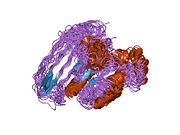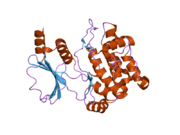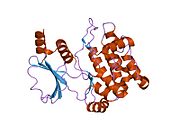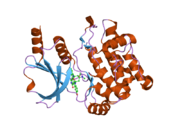Biology:PAK2
 Generic protein structure example |
Serine/threonine-protein kinase PAK 2 is an enzyme that in humans is encoded by the PAK2 gene.[1][2]
PAK2 is one of three members of Group I PAK family of serine/threonine kinases.[3][4] The PAKs are evolutionary conserved.[5] PAK2 and its cleaved fragment localize in both the cytoplasmic or nuclear compartments. PAK2 signaling modulates apoptosis,[6] endothelial lumen formation,[7] viral pathogenesis,[8] and cancer including, breast,[9] hepatocarcinoma,[10] and gastric [11] and cancer, at-large.[12]
Discovery
The human PAK2 was identified as a downstream effector of Rac or Cdc42.[3][4]
Gene and spliced variants
The PAK2 gene is about 92.7-kb long. The gene contains 15 exons and generates three alternatively spliced transcripts - two of which code proteins of 524 amino acids and 221 amino acids, while the third one is a 371-bp non-coding RNA transcript(Gene from review) There are two transcripts generated from the murine PAK2 gene, a 5.7-kb transcript coding a 524 amino acids long polypeptide and a 1.2-kb long non-coding RNA transcript.
Protein domains
Similar to PAK1, PAK2 contains a p21-binding domain (PBD) and an auto-inhibitory domain (AID) and exists in an inactive conformation.[12]
The p21 activated kinases (PAK) are critical effectors that link Rho GTPases to cytoskeleton reorganization and nuclear signaling. The PAK proteins are a family of serine/threonine kinases that serve as targets for the small GTP binding proteins, CDC42 and RAC1, and have been implicated in a wide range of biological activities. The protein encoded by this gene is activated by proteolytic cleavage during caspase-mediated apoptosis, and may play a role in regulating the apoptotic events in the dying cell.[13]
Function
The p21 activated kinases (PAK) are critical effectors that link Rho GTPases to cytoskeleton reorganization and nuclear signaling. The PAK proteins are a family of serine/threonine kinases that serve as targets for the small GTP binding proteins, CDC42 and RAC1, and have been implicated in a wide range of biological activities. The protein encoded by this gene is activated by proteolytic cleavage during caspase-mediated apoptosis, and may play a role in regulating the apoptotic events in the dying cell.[14]
Upstream activators
PAK2 kinase activity is stimulated by transforming growth factor β in fibroblasts,[15] by proteinase inhibitor alpha2-macroglobulin binding to GRP78 in prostate cancer cells,[16] by its phosphorylation by AMP-activated protein kinase in stem and cancer cells [17] and eryptosis.[18] PAK2 is cleaved through activated caspase-3 in fibroblast and cancer cells exposed to ultraviolet,[19] hyperosmotic shock,[20] and ionizing radiation.[21]
Inhibitors
The levels of PAK2 activation in experimental systems are inhibited by synthetic PAK-inhibitors and miRs. For example, FRAX1036 differentially inhibits PAK2 and PAK1 activities;[22] FRAX597 suppresses PAK2 activity in neurofibromatosis type 2 (NF2)-associated tumorigenesis;[23] and miR-23b and miR-137 inhibits PAK2 expression in tumor cells.[24][25] Insulin stimulation of neuronal cells also antagonizes PAK2 kinase activity, leading to an increased glucose uptake.[26]
Downstream targets
PAK2-mediated phosphorylation of merlin at S518 modulates its tumor suppressor activity,[27] c-Jun phosphorylation at T2, T8, T89, T93 and T286 contributes to the growth of growth factor-stimulated melanoma cells,[28] Caspase-7 phosphorylation at S30, T173 and S239 inhibits apoptotic activity in breast cancer cells,[9] Paxillin phosphorylation at S272 and S274 activates ADAM10 protease,[29] and STAT5 phosphorylation at S779 modulates BCL-ABL-mediated leukemogenesis.[30] PAK2 activity negatively regulates the function and expression of c-Myc: PAK2 phosphorylation of c-Myc at T358-S373-T400 inhibits its transactivation function [31] and PAK2 depletion stimulates c-Myc expression during granulocyte-monocyte lineage.[32]
Notes
The 2016 version of this article was updated by an external expert under a dual publication model. The corresponding academic peer reviewed article was published in Gene and can be cited as: "PAK2". Gene. http://www.example.com. |
References
- ↑ "A novel serine kinase activated by rac1/CDC42Hs-dependent autophosphorylation is related to PAK65 and STE20". The EMBO Journal 14 (9): 1970–8. May 1995. doi:10.1002/j.1460-2075.1995.tb07189.x. PMID 7744004.
- ↑ "Regulation of human leukocyte p21-activated kinases through G protein--coupled receptors". Science 269 (5221): 221–3. July 1995. doi:10.1126/science.7618083. PMID 7618083.
- ↑ 3.0 3.1 "Regulation of human leukocyte p21-activated kinases through G protein--coupled receptors". Science 269 (5221): 221–3. July 1995. doi:10.1126/science.7618083. PMID 7618083.
- ↑ 4.0 4.1 "Molecular cloning of a new member of the p21-Cdc42/Rac-activated kinase (PAK) family". The Journal of Biological Chemistry 270 (42): 25070–8. October 1995. doi:10.1074/jbc.270.42.25070. PMID 7559638.
- ↑ "PAK thread from amoeba to mammals". Journal of Cellular Biochemistry 107 (4): 579–85. July 2009. doi:10.1002/jcb.22159. PMID 19350548.
- ↑ "Caspase-mediated activation of PAK2 during apoptosis: proteolytic kinase activation as a general mechanism of apoptotic signal transduction?". Cell Death and Differentiation 5 (8): 637–45. August 1998. doi:10.1038/sj.cdd.4400405. PMID 10200518.
- ↑ "Mechanisms controlling human endothelial lumen formation and tube assembly in three-dimensional extracellular matrices". Birth Defects Research. Part C, Embryo Today 81 (4): 270–85. December 2007. doi:10.1002/bdrc.20107. PMID 18228260.
- ↑ "An emerging role for p21-activated kinases (Paks) in viral infections". Trends in Cell Biology 20 (3): 160–9. March 2010. doi:10.1016/j.tcb.2009.12.005. PMID 20071173.
- ↑ 9.0 9.1 "Phosphorylation of caspase-7 by p21-activated protein kinase (PAK) 2 inhibits chemotherapeutic drug-induced apoptosis of breast cancer cell lines". The Journal of Biological Chemistry 286 (25): 22291–9. June 2011. doi:10.1074/jbc.M111.236596. PMID 21555521.
- ↑ "P21-activated kinase-2 is a critical mediator of transforming growth factor-β-induced hepatoma cell migration". Journal of Gastroenterology and Hepatology 28 (6): 1047–55. June 2013. doi:10.1111/jgh.12150. PMID 23425030.
- ↑ "Activation of P21-activated protein kinase 2 is an independent prognostic predictor for patients with gastric cancer". Diagnostic Pathology 9: 55. March 2014. doi:10.1186/1746-1596-9-55. PMID 24621074.
- ↑ 12.0 12.1 "PAKs in Human Cancer Progression: From Inception to Cancer Therapeutic to Future Oncobiology". Advances in Cancer Research 130: 137–209. 2016. doi:10.1016/bs.acr.2016.01.002. ISBN 9780128047897. PMID 27037753.
- ↑ "Entrez Gene: PAK2 p21 (CDKN1A)-activated kinase 2". https://www.ncbi.nlm.nih.gov/sites/entrez?Db=gene&Cmd=ShowDetailView&TermToSearch=5062.
- ↑ "Entrez Gene: PAK2 p21 (CDKN1A)-activated kinase 2". https://www.ncbi.nlm.nih.gov/sites/entrez?Db=gene&Cmd=ShowDetailView&TermToSearch=5062.
- ↑ "Cell-type-specific activation of PAK2 by transforming growth factor beta independent of Smad2 and Smad3". Molecular and Cellular Biology 23 (23): 8878–89. December 2003. doi:10.1128/mcb.23.23.8878-8889.2003. PMID 14612425.
- ↑ "Binding of activated alpha2-macroglobulin to its cell surface receptor GRP78 in 1-LN prostate cancer cells regulates PAK-2-dependent activation of LIMK". The Journal of Biological Chemistry 280 (28): 26278–86. July 2005. doi:10.1074/jbc.M414467200. PMID 15908432.
- ↑ "Chemical genetic screen for AMPKα2 substrates uncovers a network of proteins involved in mitosis". Molecular Cell 44 (6): 878–92. December 2011. doi:10.1016/j.molcel.2011.11.005. PMID 22137581.
- ↑ "Proteome analysis of erythrocytes lacking AMP-activated protein kinase reveals a role of PAK2 kinase in eryptosis". Journal of Proteome Research 10 (4): 1690–7. April 2011. doi:10.1021/pr101004j. PMID 21214270. https://figshare.com/articles/Proteome_Analysis_of_Erythrocytes_Lacking_AMP_Activated_Protein_Kinase_Reveals_a_Role_of_PAK2_Kinase_in_Eryptosis/2674234.
- ↑ "Proteolytic cleavage and activation of PAK2 during UV irradiation-induced apoptosis in A431 cells". Journal of Cellular Biochemistry 70 (4): 442–54. September 1998. doi:10.1002/(sici)1097-4644(19980915)70:4<442::aid-jcb2>3.3.co;2-n. PMID 9712143. http://ntur.lib.ntu.edu.tw/bitstream/246246/163262/1/32.pdf.
- ↑ "PAK2 is cleaved and activated during hyperosmotic shock-induced apoptosis via a caspase-dependent mechanism: evidence for the involvement of oxidative stress". Journal of Cellular Physiology 178 (3): 397–408. March 1999. doi:10.1002/(SICI)1097-4652(199903)178:3<397::AID-JCP14>3.0.CO;2-2. PMID 9989786. https://semanticscholar.org/paper/49c07647a489a4085c16019ca1b001d11ce301eb.
- ↑ "p21-activated protein kinase gamma-PAK is activated by ionizing radiation and other DNA-damaging agents. Similarities and differences to alpha-PAK". The Journal of Biological Chemistry 274 (44): 31119–22. October 1999. doi:10.1074/jbc.274.44.31119. PMID 10531298.
- ↑ "Small molecule inhibition of group I p21-activated kinases in breast cancer induces apoptosis and potentiates the activity of microtubule stabilizing agents". Breast Cancer Research 17: 59. April 2015. doi:10.1186/s13058-015-0564-5. PMID 25902869.
- ↑ "FRAX597, a small molecule inhibitor of the p21-activated kinases, inhibits tumorigenesis of neurofibromatosis type 2 (NF2)-associated Schwannomas". The Journal of Biological Chemistry 288 (40): 29105–14. October 2013. doi:10.1074/jbc.M113.510933. PMID 23960073.
- ↑ "MicroRNA-23b regulates cellular architecture and impairs motogenic and invasive phenotypes during cancer progression". Bioarchitecture 3 (4): 119–24. 2012. doi:10.4161/bioa.26134. PMID 24002530.
- ↑ "miR-137 inhibits proliferation of melanoma cells by targeting PAK2". Experimental Dermatology 24 (12): 947–52. December 2015. doi:10.1111/exd.12812. PMID 26186482.
- ↑ "P21-activated kinase 2 (PAK2) regulates glucose uptake and insulin sensitivity in neuronal cells". Molecular and Cellular Endocrinology 429: 50–61. July 2016. doi:10.1016/j.mce.2016.03.035. PMID 27040307.
- ↑ "Serine 518 phosphorylation modulates merlin intramolecular association and binding to critical effectors important for NF2 growth suppression". Oncogene 23 (52): 8447–54. November 2004. doi:10.1038/sj.onc.1207794. PMID 15378014.
- ↑ "P21-activated protein kinase (PAK2)-mediated c-Jun phosphorylation at 5 threonine sites promotes cell transformation". Carcinogenesis 32 (5): 659–66. May 2011. doi:10.1093/carcin/bgq271. PMID 21177766.
- ↑ "HIV Nef, paxillin, and Pak1/2 regulate activation and secretion of TACE/ADAM10 proteases". Molecular Cell 49 (4): 668–79. February 2013. doi:10.1016/j.molcel.2012.12.004. PMID 23317503.
- ↑ "PAK-dependent STAT5 serine phosphorylation is required for BCR-ABL-induced leukemogenesis". Leukemia 28 (3): 629–41. March 2014. doi:10.1038/leu.2013.351. PMID 24263804.
- ↑ "Negative control of the Myc protein by the stress-responsive kinase Pak2". Molecular and Cellular Biology 24 (4): 1582–94. February 2004. doi:10.1128/mcb.24.4.1582-1594.2004. PMID 14749374.
- ↑ "Pak2 regulates hematopoietic progenitor cell proliferation, survival, and differentiation". Stem Cells 33 (5): 1630–41. May 2015. doi:10.1002/stem.1951. PMID 25586960.
External links
- PAK2 Info with links in the Cell Migration Gateway
- Overview of all the structural information available in the PDB for UniProt: Q13177 (Serine/threonine-protein kinase PAK 2) at the PDBe-KB.







